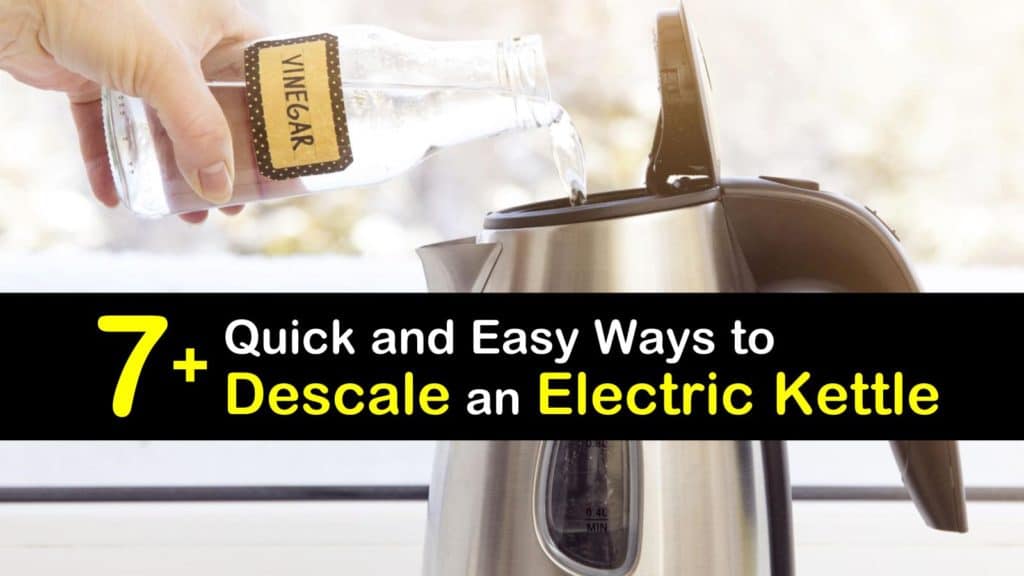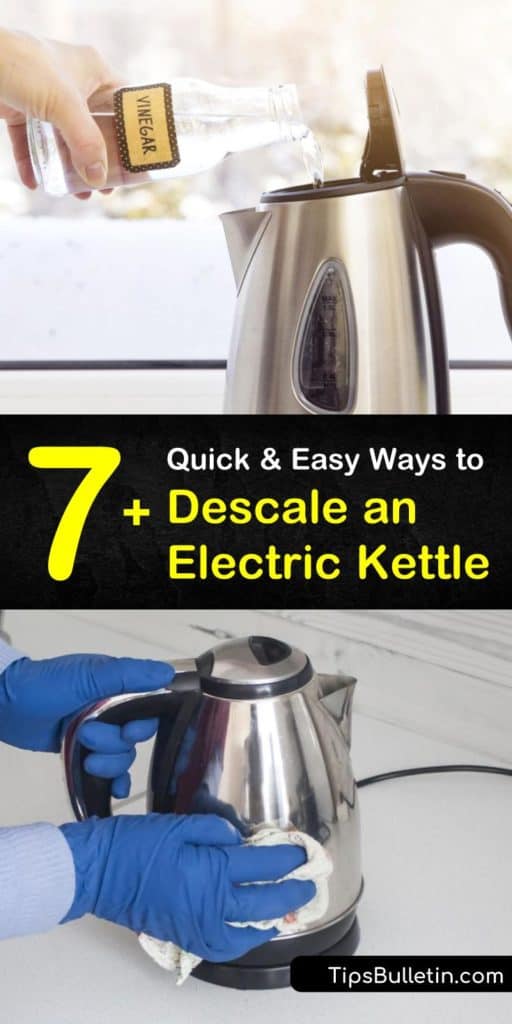Electric kettles allow users to effortlessly boil water for a cup of tea or coffee quicker than traditional stovetop tea kettles can. A majority of people use their electric kettles every day and fail to clean the appliance properly. The daily use of a kettle often leads to a harmful build-up of mineral deposits on multiple areas inside the kettle, making it essential to know how to descale an electric kettle.
Limestone deposits can hinder the performance of your kettle as well as shorten the overall life of the appliance. Specifically, the heating element of the kettle is compromised when significant build-up is present.
The limescale build-up slows down the amount of time it takes to boil water, and excess mineral deposits can fall into the water. Knowing how to descale an electric kettle is not only easy but necessary to prevent kettle furring.

- Using Household Items to Remove Limescale from a Tea Kettle
- Use Vinegar and Water to Get Rid of Calcium Build up in the Kettle
- Citric Acid is an Effective Way to Clean a Kettle
- How to Descale an Electric Kettle with Lemon Juice
- Clean the Hard to Reach Areas of Your Kettle with Baking Soda
- Descaling a Kettle using Apple Cider Vinegar
- Kill Bacteria in Your Kettle with Coca-Cola
- Restore an Electric Kettle with Olive Oil
Using Household Items to Remove Limescale from a Tea Kettle
We provide you with amazing DIY methods that show you how to descale an electric kettle using only common household ingredients. These tips and tricks demonstrate how to keep your electric kettle looking and working as if it were brand new.
There are several quick and easy ways to descale a tea kettle using frequently bought household items. Simple ingredients like vinegar, baking soda, and even lemon juice can all be used to get rid of the calcium deposits found in your kettle.
Descale a water kettle and take care of cleaning a stainless steel coffee pot with these easy to follow cleaning hacks. They work great and do not require significant effort, either.
Use Vinegar and Water to Get Rid of Calcium Build up in the Kettle
Vinegar is a common solution used to clean a variety of different materials like countertops and hardwood floors. A vinegar solution is also an all-natural way to get rid of limestone deposits found in an electric kettle.
The active cleaning ingredient in vinegar is acetic acid. The acid allows the liquid to eat away at organic matter found in your kettle.
Start the cleaning process by filling your kettle with equal parts water and vinegar until about ¾ full. Turn on the kettle and wait for the water to start boiling. After you can see the water boiling, turn your kettle off (if it does not do so automatically).

Let the acetic acids in the vinegar solution sit in the kettle for about 20 minutes. Afterward, be sure to pour the mixture from the kettle down the drain. Rinse the kettle after the solution is poured out to get rid of the vinegar scent.
Use this simple solution as a DIY coffee machine descaler, too. The results are fantastic!
Citric Acid is an Effective Way to Clean a Kettle
Citric acids are another natural way to kill the bacteria and calcium build up in your kettle. Citric acids are also called triprotic acids. Triprotic acid kills the biofilm bacteria identified in widely found pH balances.
The bacteria-eating solution allows citric acid to act as an effective all-natural disinfectant that kills bacteria, rust, mildew, calcium deposits, limescale, and mold.
Here’s how you can descale an electric kettle or if you need to deal with descaling a Keurig coffee pot with citric acid powder. Fill your kettle with water until it reaches the halfway mark and bring the water to a boil. Turn off your kettle if it does not do so automatically.
Pour the citric acid powder into the boiling water and allow the mixture to sit inside the appliance for 20 minutes.
After the mixture sits for the allotted time, pour it out. Again, rinsing your kettle afterward will help get rid of the scent of the citric acid powder.
How to Descale an Electric Kettle with Lemon Juice
Lemons are terrific natural cleaning products. The acids found in the fruit are antibacterial and antiseptic, which allow lemons to clean as effectively as bleach. Additionally, the oils that are found in the rind can help shine the glass portion of the kettle.
Slice the lemon into thin, round slices, then place the slices inside your kettle. Next, fill your kettle with water and turn it on. The water must be filled high enough to cover any spots that have calcium deposits on them.
Allow the water to boil with the lemons inside the kettle, then turn your appliance off. Let the water and lemons sit inside the kettle for at least 30 minutes. Pour the water down the drain after the mixture has set.
We recommend that if the calcium build-up in the kettle is severe, you boil the water a second time to ensure your kettle is completely cleaned.
Clean the Hard to Reach Areas of Your Kettle with Baking Soda
Knowing how to descale a kettle with baking soda can save you time while also removing the limescale buildup. This household product is a mild alkali, which causes dirt and grime to dissolve when the baking soda mixes with water.
Additionally, baking soda acts as a natural deodorizer and eliminates odor molecules by bringing them into a neutral state. The active ingredients found in baking soda offer a way to clean both the inside of your electric kettle and the more intricate areas.
Put both ingredients inside the kettle and bring the water to a boil for up to 15 minutes. Turn the appliance off. To ensure that the removal of the limescale from the tea kettle is complete, let the solution sit for another 15 minutes.
After the allotted time has passed, pour out the solution. You can finish descaling a kettle by rinsing it out with water.
Mix both ingredients in a small dish or container and stir until it forms a paste. Put a small amount of the substance on the toothbrush and scrub the affected areas.
We recommend that you rinse your kettle after you have scrubbed an area, as it allows you to see if additional scrubbing of a hard water area with a higher build-up of limescale is necessary.
Descaling a Kettle using Apple Cider Vinegar
Similar to a regular vinegar solution, apple cider vinegar can be used to effectively remove calcium deposits from your electric kettle.
Apple cider vinegar also contains acetic acid. The acids help eat away at the organic matter and calcium deposit build up in your electric kettle.
Pour all of the ingredients inside your kettle. Turn your kettle on and allow the mixture to boil for 15 minutes. Boiling the apple cider vinegar solution allows the calcium build-up in the kettle to be eaten away.
After the water has boiled, pour the solution down the drain. Finally, rinse out your kettle to better remove the scent of the apple cider vinegar solution. Keep an eye on the boiling water to make sure the liquid does not evaporate.
Apple cider and white vinegar are also ideal for many other cleaning purposes. Use one or the other to descale your dishwasher, clean hard water spots off windows, and eliminate calcium build-up from your showerheads.
Use vinegar to clean the toilet tank and bowl, as well. There are tons of uses for this simple household product.
Kill Bacteria in Your Kettle with Coca-Cola
Knowing how to remove limescale from a tea kettle with Coca-Cola allows you to effectively clean your electric kettle even when you have limited resources. Coca-Cola is a highly acidic soda that kills bacteria and germs.
Coca-Cola has a pH level of 2.8, meaning it can clean and store-bought products that contain chemicals. Empty the contents of a 20 ounce Coca-Cola bottle into your tea kettle.
Turn on your kettle and let the liquid boil. Turn your kettle off, and let the soda sit for up to 30 minutes. Pour the soda down the drain and rinse your kettle out.
Restore an Electric Kettle with Olive Oil
If you have a stainless steel kettle, using olive oil can help keep the surface shiny and looking brand new. This all-natural solution allows you to keep the outside of your kettle as clean as the inside.
Put the olive oil onto the microfiber cloth and gently rub the stainless steel surfaces with a cloth. Rub the microfiber cloth in the same direction as the grain of the stainless steel to help the oil soak into the surface.
After you finish polishing your kettle, wipe it down with a piece of paper towel to get rid of the excess olive oil.
These simple and powerful cleaning methods use household products to disinfect your electric kettles and other small kitchen appliances, like a coffee maker or a regular tea kettle, better than a dishwasher can.
Knowing how to descale an electric kettle is important to get rid of all the excess mineral deposits in your kettle. It can also help extend the life of the appliance.

If these DIY cleaning hacks helped show you how to descale an electric kettle, please share this article with tips on how to remove limescale from a tea kettle with your family and friends on Facebook or Pinterest.